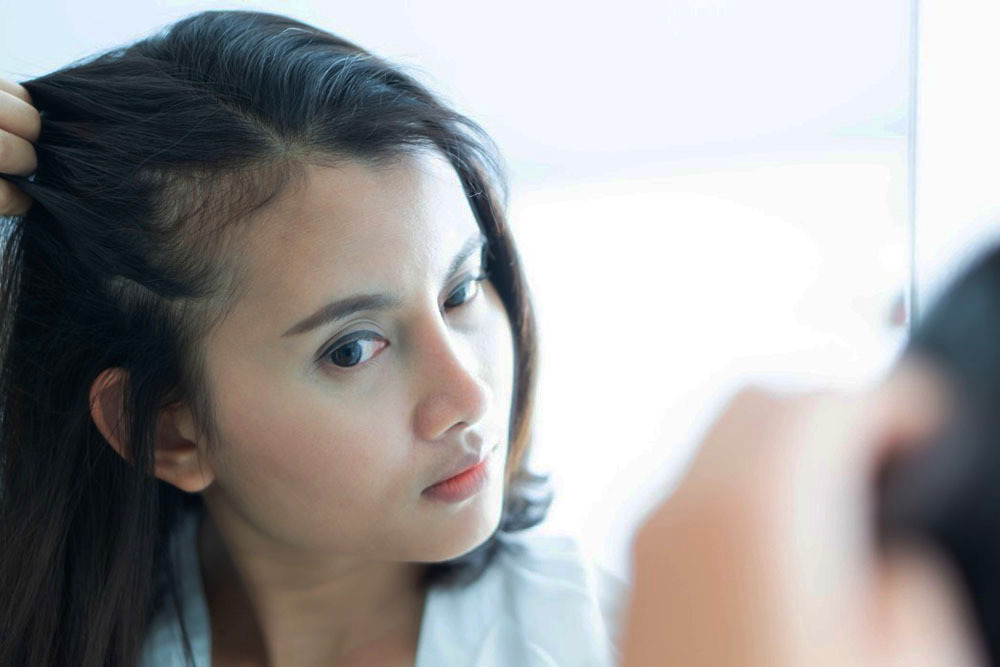Expert Advice On Postpartum Hair Loss and Treatment

While normal, losing your locks after giving birth can be quite a shock. Here’s what you can do about your hairy (and often scary) situation.
Medical Expert: Aimee Paik, MD, FAAD
Plenty of birth parents have experienced that moment in the shower (the warm, relaxing place where you’re supposed to find solitude during the newborn haze) when it begins: A few strands here, a few strands there; you start to realize it’s not your mind playing tricks on you … yep, you’re losing a lot of hair.
I had that moment in the shower, and again when brushing my hair, and again when I woke up in the morning to find hair all over my pillow and sheets. It just kept falling out and was frightening to witness, not knowing when or if it would stop. Would it grow back? Would my new hair be the same? There was a lot I didn’t know about hair shedding after birthing a baby—primarily to anticipate it in the first place because it’s simply part of the postpartum period (though it’s an unfortunate side effect, there’s no argument there).
To help make sense of postpartum hair loss, we tapped Aimee Paik, MD, FAAD, SVP of Dermatology at Hims & Hers, on what to expect and options for treatment.
Q: Why Does Postpartum Hair Loss Happen?
A: Postpartum hair loss is physiologic, meaning it’s normal, and everyone will experience it after delivering a baby due to fluctuating hormone levels. Hair follicles have a natural growth cycle consisting of an active growth phase (anagen), a transitional phase (catagen), a resting phase (telogen), and then a phase where the hair falls out (exogen)—this then repeats itself. During pregnancy, however, hair follicles are kept in an abnormally prolonged growing phase, which is why hair may feel or appear thicker during pregnancy—and why more seems to fall out after delivery.
Q: How Long Does Hair Shedding Last?
A: Typically, about two to four months postpartum, hair reverts to its regular hair growth cycles that were experienced pre-pregnancy. This is usually when hair shedding is the most noticeable, as all the hair that remained during the prolonged growth phase during pregnancy falls out.
It’s a common misconception that postpartum hair loss happens in specific spots or around the hairline; it’s simply more noticeable there. In actuality, new parents experience shedding throughout the entire scalp.
Generally, postpartum hair loss will resolve within six weeks to six months. If your hair loss is severe or persists for more than one year, I’d consider treatment and recommend seeking advice from a dermatologist or other health care professional.
Q: Can Postpartum Hair Loss Be Prevented?
A: There is nothing that can be done to prevent postpartum hair loss, as it’s a normal physiological response to changing estrogen levels and other pregnancy hormones. But hair loss can also be caused by certain vitamin deficiencies (namely iron and vitamin D) or thyroid abnormalities, which can commonly be triggered by pregnancy. I recommend taking a prenatal vitamin regularly and following up with your doctor if you have any concerns about thyroid disease or its symptoms (such as prolonged dry, brittle, or thinning hair on your scalp and body). When left untreated, thyroid conditions can cause hair loss.
Q: What Are the Treatment Options?
A: The treatments that could help with postpartum hair loss and regrowth include over-the-counter products like Minoxidil and Biotin vitamin gummies. Postpartum hair loss can sometimes unmask a predisposition to female pattern hair loss (a genetic form of hair loss), making it more evident. In the event of long-standing hair loss, prescription hair loss treatment with oral spironolactone may be helpful.
In addition to these helpful tips from Dr. Paik, practicing general hair care (gentle brushing, less styling with heat, routine hair masks, etc.) and eating a balanced diet will help strengthen your remaining mane. Deficiencies in nutrients can negatively affect hair, so aim to consume foods high in protein, biotin, vitamins A, C, and D, iron, and zinc. Additionally, you can try switching up your hairstyle (whenever you’re not rocking a messy mom-bun) to create the appearance of thicker hair if it makes you more comfortable. (Bonus if it’s shorter, as we know babies have firm grips.) And try to remember that this too shall pass, so keep your head up—no matter what’s on top!








